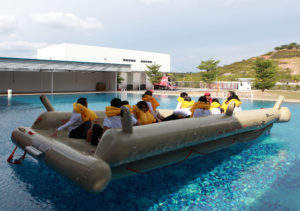
Photo: Adam Lee
Life Raft Training – Flight crew safely on board
What happens if a plane loses all its power?
Even though I have hung up my pilot’s uniform, it’s refreshing to reminisce over Vipul Lal’s question during this Covid-19 lockdown. Via Quora, he further added, “I know that a commercial liner can glide for some distance, but what if it is over the Ocean?”
Yes, planes can glide safely with the loss of all engines. At 40,000 feet, an airliner can glide about 100 nautical miles or 160 kilometers.
A Canada Air Boeing 767 from Montreal to Edmonton ran out of fuel in 1983. It lost both the engines but successfully glided to land at a disused runway at Gimli.
In another incident, an Air Transat Airbus A330 with 306 passengers over the Atlantic Ocean ran out of fuel in 2001. It successfully glided with both engines failed to a small air force base about 120 km in the Azores.
What happens if it is over the ocean?
If the pilot can control the emergency glide landing onto water, this is known as a ditching.
On January 15, 2009, an US Airways Airbus A320 flight from New York City to Charlotte struck a flock of Geese after take-off and lost all its engine power.
The captain successfully ditched the plane onto the Hudson River, saving 155 passengers and crew on board.
What if it were over the ocean?
If the water is calm, the ditching outcome is likely to be good.
In the Boeing 777 that I flew, the manufacturer stated that, if the ditching is properly handled, the airplane should come to a rest slightly nose high on the water.
Passengers would then evacuate into each life raft (see pic above) that can accommodate up to 58 survivors.
Out of the 8 life rafts, two are equipped with emergency locator transmitters (ELT) that are activated automatically when it is wet. The ELT would assist rescue aircraft to locate the survivors’ position and will continue to transmit emergency signals for 50 hours up to 280 miles.
If it rains or is sunny, the survivors could erect an orange fabric canopy. It has many aids to attract the attention of rescue aircraft or ships such as heliograph which is a specially designed mirror to be used in bright sun light.
There are the day-night flares to be used when rescue aircraft or ships are sighted. Sea dye markers are provided to ensure the trails of the dye can be easily seen from the air.
If survivors are thirsty, there is drinking water; hungry, barley glucose sugar to munch on. Feeling sea-sick? There are ‘Sea Legs’ tablets.
When it gets dark, there are flash lights.
If the raft leaks, it can be mended with repair clamps; excess water can be sponged and even a bailing bucket is provided. There is also a hand pump to inflate a slightly deflated raft.
Finally, feeling bored? There is a survival manual to read until you are rescued!
Conclusion
In life, we always wish for a positive outcome. This is my answer if the weather is fine and the sea is calm.